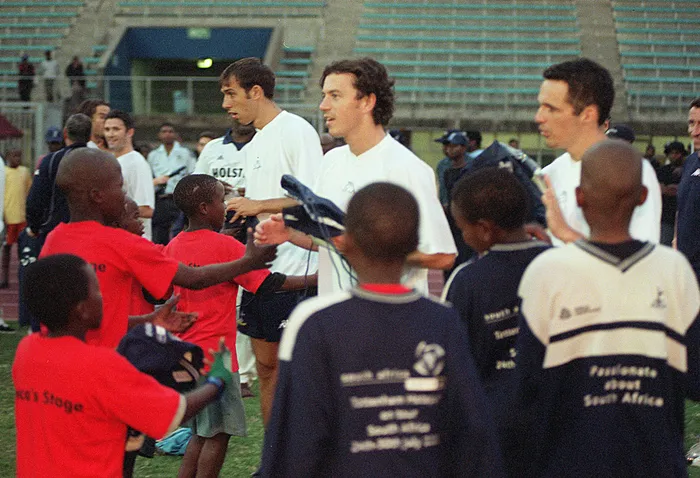South African Tourism wants to sponsor football club Tottenham Hotspur - is it a good idea?

Picture: ANA files – Tottenham Hotspur players in Durban meet the the fans. But is a R900 million sponsorship of the UK football team over three years worth it for South Africa?
By Brendan Knott
South African Tourism (SA Tourism) is reported to be planning to spend US$52 million (about R900 million) to sponsor UK football team Tottenham Hotspur over three years. The proposal gives the country branding on the club’s kit, backdrop branding in interviews, advertising on match days, partnership status, local training camps and access to tickets and stadium hospitality. Football has a massive TV viewership and can attract big spending and big eyeballs. But is it an effective way to market a country? And is it money well spent? Brendon Knott researches nation branding and football. The Conversation asked him four questions.
Is this a good idea for nation branding?
Sponsorship of a sport team, event, or of individuals is an accepted and proven marketing communication tool. As countries, regions and cities are increasingly competing in the global marketplace for the attention of potential customers – in this case tourists – some destinations have also embraced sport as a marketing medium.
Typically, destinations promote themselves through associating with a sport event or team within their geographic location. In Spain, for example, Visit Catalunya sponsors Spanish club FC Barcelona.
It’s less common for a destination to use a more strategic approach to connect with a desired audience in another location.
Can it help tourism?
We need to understand that tourism destinations are “brands”, which compete against other brands for attention. SA Tourism therefore has a mandate and a budget to attract global tourism. There are a number of ways to promote a brand or engage with a target audience. Sport sponsorship has grown in favour as a marketing tool as it has shown an ability to break through the advertising clutter and get customers’ attention. It reaches them in a place where they are generally relaxed and can be engaged through a common passion for sport.
A sponsorship can achieve various objectives for a brand. Most commonly, the organisation seeks greater awareness of the brand, by making it visible on the players’ jerseys and signage around the stadium. This is most helpful for new or relatively unknown brands in a market, or to keep a brand top-of-mind among consumers in that market.
The second major objective is to enhance or change the brand image among a target audience through the association with a sport team. Brands typically benefit from a more favourable perception by fans of the team being sponsored. This is why the global sport sponsorship industry was estimated at US$77.69 billion in 2022 and is projected to grow at a rate of 8% over the next few years.
From what has been shared by SA Tourism, it appears that their objective is to reach the global audience that follows the football Premier League, and particularly reach the key UK tourism market. However, it is debatable whether this high profile, high cost approach is the best way to spend their marketing budget to boost international tourism.
Are there any precedents for this approach?
Two other high profile examples of destinations sponsoring football clubs in the past decade are Malaysia sponsoring UK team Cardiff City in a US$3.6 million deal in 2013; and Rwanda’s US$12 million a year sponsorship of UK team Arsenal FC, where “Visit Rwanda” is emblazoned on the sleeve of the team kit. Signed in 2018, the Rwanda agreement has been particularly slammed as an attempt at “sportswashing”. This refers to the covering up of human rights abuses within the African nation by trying to garner goodwill through the sponsorship.
In this case, the Rwandan president Paul Kagame is known to be a fervent supporter of Arsenal. Sports marketers would cite this as an example of a “chairman’s folly” approach to sponsorship. In the SA Tourism case, the strategic reasoning governing their decision has not been fully disclosed.
With the recent men’s football Fifa World Cup still fresh in our memory, the example of Qatar and sport sponsorship is also relevant. Besides multiple sport event sponsorships, the Qatar Foundation sponsors FC Barcelona, while Qatar Airways sponsors another European football giant, PSG. These sponsorships have often been questioned as attempts by the nation to deflect attention from criticism relating to workers’ rights and other human rights and freedoms. It is too early to assess whether the hosting of the World Cup aided the Qatar image or development of its tourism economy.
What are the potential downsides?
The media and public backlash at the SA Tourism sponsorship agreement indicates the lack of local public support for this initiative. Instead of viewing this as a good marketing opportunity that could bring in tourism revenue, there is the view that the government money could be spent better – either on sponsorship of local sports or on other projects altogether. Destinations should not aim to boost their “external” brand at the expense of the valuable “internal” brand strength.
The examples of Rwanda and Qatar, in particular, indicate that the negative media associated with perceived sportswashing diminishes the anticipated benefits. In the case of South Africa, it may appear as an attempt to counter the damaging global media coverage relating to the power crisis and other high profile challenges experienced in the nation. SA Tourism has given conditional approval to the plan, which is expected to go ahead in the next few months despite a growing backlash.
This article was first published on The Conversation